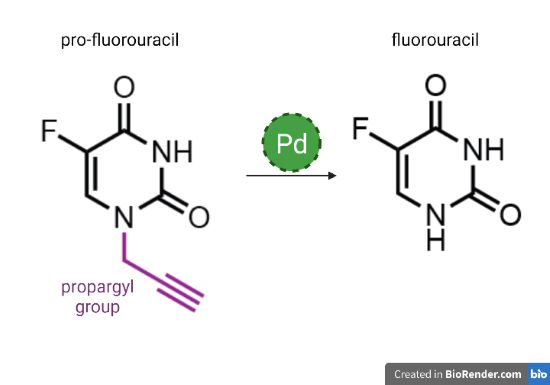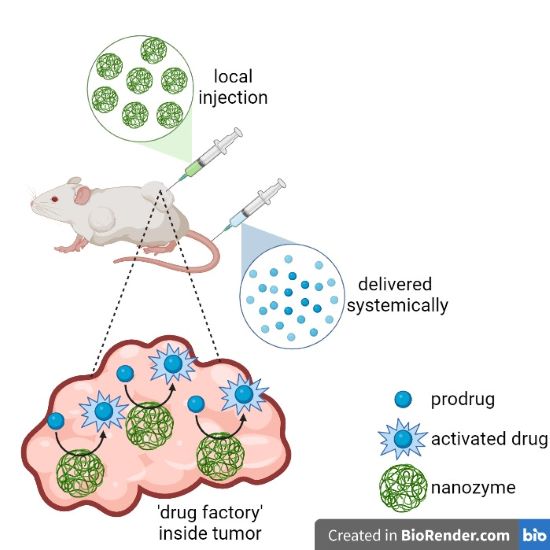Targeted treatment just as effective, safer than standard chemotherapy in mouse model of triple negative breast cancer
Chemotherapy is a mainstay of cancer treatment. While effective, this therapy indiscriminately kills rapidly dividing cells—cancerous or otherwise—so patients frequently experience severe side effects, ultimately limiting its utility.
But what if there was a way to administer an inactive chemotherapeutic throughout the body and ‘turn on’ the drug inside of a tumor? This strategy could limit side effects while potentially allowing for higher-dose (and more effective) treatments.
Enter nanozymes. These artificial enzymes, composed of nanomaterials, can carry out pre-determined chemical reactions, such as converting an inert drug (or prodrug) into its functional form. If injected into a tumor and exposed to a prodrug, nanozymes could become localized ‘drug factories,’ selectively activating a cancer drug within the tumor while minimizing damage to healthy tissues.
Bioengineers and chemists at the University of Massachusetts Amherst (UMass Amherst) have developed a nanozyme that can turn an inactive form of fluorouracil, a commonly used chemotherapeutic, into its active form. When evaluated in a mouse model of breast cancer, their treatment could shrink tumors just as effectively as standard fluorouracil chemotherapy with significantly less liver damage. By increasing chemotherapeutic doses at the tumor site and not throughout the body, this strategy could potentially provide just as much therapeutic benefit as standard chemotherapy with significantly less toxicity. Results from this method were recently reported in The Journal of Controlled Release.
“Developing targeted, safer therapies for cancer treatments will always be a major priority in the field,” explained Luisa Russell, Ph.D., a program director in the Division of Discovery Science & Technology at NIBIB. “This research demonstrates a way to make an existing chemotherapy less toxic without sacrificing efficacy in a preclinical model of breast cancer. Notably, this technique could potentially be applied to other types of drugs, paving the way for targeted treatments for a variety of different conditions.”
Building tumor-specific drug factories
Here’s how the nanozymes are designed: ultrasmall gold nanoparticles are densely coated with positively charged molecules, making them strongly attracted to cell surfaces (which are negatively charged). Next, a metal catalyst—in this case, palladium—is added to the interior of the nanoparticles. Palladium powers the activity of the nanozymes and can perform bio-orthogonal catalysis (reactions that don’t naturally occur in our bodies). Specifically, palladium can remove molecules called propargyl groups, which can be added to drugs to block their activity.

“Metal catalysts, like palladium, are emerging as a new way to selectively activate prodrugs in biological systems,” said senior study author Vincent Rotello, Ph.D., a professor of chemistry at UMass Amherst. “By encapsulating palladium into our ultrasmall, positively charged nanoparticles, we can electrostatically ‘velcro’ the nanozymes to the tumor tissue, anchoring the catalyst in place," he explained. When a prodrug is added, it travels through the body but is activated within the tumor, improving therapeutic efficiency while also decreasing off-target effects, he added.
Their treatment combines the palladium-filled nanozymes with pro-fluorouracil (a version of the drug that is tagged with a propargyl group). After the nanozymes are injected directly into the tumors, mice are given pro-fluorouracil systemically (so that the drug circulates throughout the entire body). Once the drug travels to the tumor, the nanozymes cleave off the propargyl group, activating the chemotherapeutic which then kills the surrounding cells.
The researchers compared their nanozyme treatment with standard fluorouracil in mice with breast tumors. While both treatments markedly shrank the tumors, mice that were given standard fluorouracil experienced significantly more liver damage (which is the most common side effect of fluorouracil-based chemotherapy).

“Our palladium-filled nanozymes could potentially be used with any drug or compound whose activity can be blocked by adding a propargyl group,” said Rotello. “We are generating chemotherapeutics, anti-microbials, and anti-inflammatories using this strategy.” He also noted that other metal catalysts could be added into the nanozymes (which could perform different bio-orthogonal reactions that activate additional prodrugs).
“While our strategy will need some fine-tuning before it can be evaluated in humans, I believe that nanozyme-facilitated drug delivery could be a potential gamechanger for targeted, safer treatments.”
This research was supported by grants from NIH, including NIBIB (R01EB022641), the National Institute of Environmental Health Sciences (NIEHS; U01ES026140), and a National Research Service Award from the National Institute of General Medical Sciences (NIGMS; T32GM139789), along with a grant from the National Science Foundation (NSF; grant 2108044).
This Science Highlight describes a basic research finding. Basic research increases our understanding of human behavior and biology, which is foundational to advancing new and better ways to prevent, diagnose, and treat disease. Science is an unpredictable and incremental process—each research advance builds on past discoveries, often in unexpected ways. Most clinical advances would not be possible without the knowledge of fundamental basic research.
Study reference: Zhang X, Liu Y, Doungchawee J, et al. Bioorthogonal nanozymes for breast cancer imaging and therapy. J Control Release. 2023;357:31-39. doi:10.1016/j.jconrel.2023.03.032
